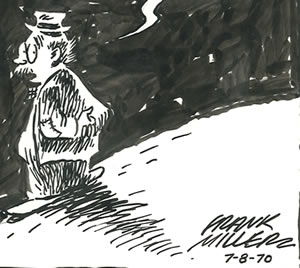
Growing up with a dad who was a newspaper man, I can vividly recall the countless front pages of the many Midwest newspapers my dad either subscribed to or kept up with on a regular basis. Let’s see. At any one time in our Boller household, my dad would pick up and read: The Wayland News, The Winfield Beacon, The Mt. Pleasant News, The Iowa City Press Citizen, The Daily Iowan, The Cedar Rapids Gazette, The Des Moines Register, The Kansas City Star, The Minneapolis Star Tribune…and, of course, to keep up with his White Sox…The Chicago Tribune. Click here to read more about the history of newspapers in Iowa.
Being around all those newspapers, I became very familiar with the fine art of editorial cartooning – an art that is nearly lost today due to the explosion of on-line communications. But, back in the day, a political cartoonist worth his or her salt truly proved the proverbial statement: a picture is worth a thousand words.


Political cartoons have been a staple of American history as long as there’s been political dissent. Benjamin Franklin’s 1754 “Join or Die” showed how an artist can distill a complex political issue into to a single, potent image, helping create a sense of American nationhood, and ultimately fueling the fight for independence.

During the Civil War, artist Thomas Nast created some of the most instantly recognizable images in U.S. politics, including Uncle Sam, the Republican elephant and the Democratic donkey. Nast also gave us our most recognized version of ole’ St. Nick, as well.

Without a doubt, Iowa has a rich tradition of turning out some of the best-known political cartoonists the world has known. Here, I’d like to introduce you to six artists with deep Iowa connections; two of which won Pulitzer Prizes for their amazing work. Allow me to start with a lesser-known artist from Iowa City, who began his career by drawing political cartoons surrounding the local controversies of his day.









For over a hundred years, the front page of The Des Moines Register featured a daily editorial cartoon, establishing a tradition of political commentary in Iowa. In 1906, the Register hired Jay N. “Ding” Darling, who drew for the newspaper until his retirement in 1949. Darling was temporarily succeeded by his long-time assistant, Harold I. “Tom” Carlisle, who occasionally produced cartoons in Darling’s absence and after his retirement. In 1953, the Register hired Frank A. Miller to continue producing editorial cartoons. Miller remained with the newspaper until his untimely death in 1983, when Brian Duffy became the full-time staff cartoonist. Duffy drew for the Register until 2008, when his position was abruptly terminated during budget cutbacks. Together, Darling, Carlisle, Miller, and Duffy produced a century of cartoon commentary and their drawings provide a unique view into the past.



Jay “Ding” Darling was born in Norwood, Michigan in 1876, but spent most of his early years in Sioux City, Iowa. Darling began drawing cartoons at an early age, and while at Beloit College (Wisconsin) studying pre-medicine, Jay became the editor of the school yearbook. He decided to make things more interesting by adding humorous sketches of campus events and professors, so to keep his identity secret, he used a contraction of his last name D’ing. The name stuck, and so did his newfound career as a cartoonist. Interestingly enough, the political side of Ding did show through at Beloit and some of those drawings for the yearbook actually got him suspended for a year! (He drew the faculty pictured as a line of ballerinas!)

Graduating in 1900, Ding decided that journalism was his passion, so he joined the staff of his hometown newspaper. The Sioux City Journal, and after sketching a courtroom scene, was given the assignment of drawing a daily cartoon. Following his marriage to Genevieve Pendleton in 1906, Ding became the cartoonist for The Des Moines Register and Leader, an association that continued, except for a two-year stint with the New York Globe, until he retired in 1949.

Beginning in 1917, his cartoons were distributed by the New York Tribune and its syndicate. His cartoons on the deaths of William F. “Buffalo Bill” Cody and of Pres. Theodore Roosevelt (in 1917 and 1919, respectively) were particularly notable. After World War I his work stressed the League of Nations as a hope for world peace. He won his first Pulitzer Prize in 1924 and his second in 1943. Darling was also a vigorous conservationist who served as chief of the U.S. Biological Survey (1934–35) and first president (1936) of the National Wildlife Federation.






Herbert Hoover and Jay “Ding” N. Darling – President Hoover and political cartoonist, Ding Darling, were friends from 1919-1962. Read more here.



Harold I. “Tom” Carlisle was born on February 17, 1904 in Jefferson, Iowa. After graduating from the University of Iowa, Carlisle took a job with The Des Moines Register, where he worked as an assistant to J. N. “Ding” Darling, the newspaper’s long-time cartoonist. Carlisle’s main duties involved “inking” many of Darling’s cartoons, but he also drew his own cartoons in Darling’s occasional absence. Below is a good example of a cartoon that was designed by Darling but inked by other artists such as Tom Carlisle.

After Darling’s retirement in 1949, Carlisle served as the Register’s primary cartoonist until his own retirement in 1953.



Frank Miller was born on March 28, 1925 in Kansas City, and was introduced to cartooning at an early age by his father, who was a political cartoonist for The Kansas City Star. The younger Miller studied art at the University of Kansas and the Kansas City Art Institute before serving in the Third Army in Europe during World War II. It was at the Institute where Frank met his future wife, Catherine. After the war, Frank returned back home, married Catherine, and followed in his father’s footsteps as a staff artist with The Star.
In 1951, Des Moines Register editor Kenneth MacDonald offered Miller the position of cartoonist as Miller’s former teacher, Karl Mattern, a Grant Wood contemporary, had recommended him for the job. Frank was unable to accept for nearly 18 months because he was recalled for active duty with the Seventh Division (artillery) during the Korean War.


Finally in 1953, Miller joined The Register where he embarked on a distinguished 30-year career in editorial cartooning. During that time, Frank drew more than 10,000 cartoons, receiving many honors, including the National Headline Award in 1957 and the Freedom Foundation Award six times between 1955 and 1964. He also received the Courage in Journalism Award of the Des Moines chapter of Sigma Delta Chi in 1961 “for placing people, foibles and the times in their proper perspective by deflating stuffed shirts and debunking sacred cows wherever he finds them.” In 1963, Miller won his highest honor: the Pulitzer Prize for political cartooning, making it the third time a Des Moines Register artist received this coveted award since its inception in 1922.
Miller, who was plagued by a chronic alcohol problem, kept it a secret from the public and most of his colleagues until late in his life. After participating in a treatment program, he worked tirelessly to help others afflicted with the disease. At the time of his premature death in 1983 (age 57), Frank’s work was being widely syndicated in nearly 50 newspapers throughout the country.



Below we picture a fine collectible set of Miller art prints from the 1970’s. These prints convey the Four Seasons of Iowa, as only Frank Miller can do.









John Holladay – staff artist -The Quad Cities Times. In 1975, a graphic arts school teacher from Davenport, Iowa sold a Nebraska Cornhusker sports cartoon at an Omaha art show. That began a successful career in cartooning for the Hawkeye artist, John Holladay, who went on to sell five million sports posters as he worked a day job as staff artist at The Quad Cities Times. Click here to read more about John’s amazing sports marketing story.



Finally, let’s close this overview of political cartooning in Iowa by giving a tip of the hat to Brian Duffy – political cartoonist with The Des Moines Register from 1983-2008. Brian took over for Frank Miller, after his sudden death, and quickly became yet another Iowa artist who made a name for himself poking fun at politicians and anybody else who rightly deserved it! Click here to read more about Duffy and his famed political artwork.
Thanks George, Ding, Tom, Frank, John and Brian for over 150 years of political cartooning in Iowa. May your art live on forever!


Kudos to the amazing resources below for the many quotes, photographs, etc. used on this page.
Pulitzer Prize for Editorial Cartooning, Wikipedia
Political Cartoons, PBS History Detectives
Jay Norwood Darling, American political cartoonist, Britannica
Editorial Cartoons of Ding Darling, University of Iowa Library
Editorial Cartoons of Frank Miller, University of Iowa Library
Frank Andrea Miller, University of Iowa Biographical Dictionary of Iowa
Cartoonist Frank Miller’s tribute to Ding, University of Iowa Digital Library
Pulitzer Prize-winning Cartoonist Frank Miller dies, UPI Archives, February 18, 1983
Editorial Cartoons of Harold “Tom” Carlisle, University of Iowa Library
Harold I. “Tom” Carlisle, Find-A-Grave
Click here to go on to the next section…
Click here for a complete INDEX of Our Iowa Heritage stories…
